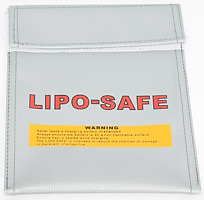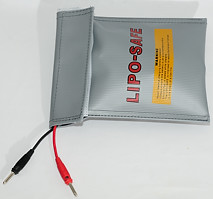@2100: Woah, never knew these things could explode. I thought that stuff was soft enough to just crack open a bit and release the pressure..
Depends on the cause !
.
.
If the fault is in the charger [ a short or something ] the the potential is there at any voltage … …
If its the battery itself , two things to watch for , heat and over voltage … …
So if the charger fails to terminate , or if the battery suddenly resists charging at a lower voltage [ still a decent charge current ]
Under normal conditions , the charger should be trickle charging at such a low level that even if it does not terminate , the battery and charger should be in a state of stalemate , or a situation where it would take hours and hours to charge another 100mAh …
So again , the chicken or the egg ?
.
.
Cells exploding @ 4.27 4.28v … I hate to say this , but that is dangerously close to 4.2v and little in the way of safety margin ! [ and Im not sure its the case ]
.
.
What is certain , is you need a MM to monitor your batteries , otherwise your going it blind . You need to know your batteries , there usual charge rate [ voltages on termination - voltage sag after say 60 minutes of rest ] There should be a sticky on every flashlight forum ! , in fact I will post one on my web now that I think of it !
I store all my cells in a surplus ammo box for belted 20mmx139 Oerlikon autocannon cartridges. A lot beefier (9kilograms/ 19.8lbs, empty! ) compared to the average .223 NATO ammo box. Now, I am wondering if that stout 20mm box could handle the pressure of an exploding 18650… and still, how to vent/ release all the pressure once it has blown? It’d probably shoot everything out of the tiny hole you’d have to drill for the power cord, to power the charger, anyways. Weak spot IMHO.
What is the price for a stick of dynamite, these days? Eventually, cheap XXX-Fire Li-Ion cells might become a cost-effective alternative ![]()
Anyways, thanks a lot for the essay!
Now I know I was right to charge my solarforce 16350s in the garden only, covered by an old 40lbs sand stone feeding through turned upside-down. But now, I am a wee wit worried about my protected Trustfire 18650s, though. They seemed to be decent…? One will never know. Might hold up to a hundred charges, might eventually disintegrate within milliseconds the next time I put it in my WP2. Am I worrying too much?
The PCB are designed to protect from common electrical faults like over-current or under-voltage, not everything under the sun. If these aren’t the culprit, seems likely this cell failed simply due to physical/chemical manufacturing defects.
It’s like claiming not to trust in seatbelts anymore because some guy burned to death in his car.
@ubehebe. Any idea how long the batt had been charging before it exploded? What the starting v was? A couple weeks ago I was charging a crapfire & 30 min in I checked with my hand & it was to hot to touch. It could have been moments from exploding yikes.
Keith
The OP did say his cell is protected, but did not mention any dead short testing.
For me i test each and every expensive and cheaper TF Flames with a dead short on the DMM. It should just jump a bit on the meter. In fact I still do that occasionally even though i am not getting new cells.
That is because my SR3800 driver (the Sky Ray 3800 original triple XM-L) did present to me a dead short.
For charging/overcharging, i do DMM each and every cell very regularly, it’s just a habit coz I have many multi-cell lights. Max I get is 4.230V-4.235V should I leave it there for too long. (sometimes it goes back into charging for 3 secs and terminates….but if you do this for too long then obviously it slowly inches up, till maxes out at 4.23V). Actually i charge at the yard area already, which is like semi-outdoors + nicely ventilated. Actually nearly 4.3V is extremely cautious/conservative but for our use we can’t be too cautious (it’s BLF here), there are some vids on youtube showing higher voltages.
It seems to me that a temp sensor that will shut down the charger if the temp of the cells gets too high is a good idea.
That could be in the charger or installed in the power line between charger and wall plug.
Also, don’t some cells already have a protection circuit that does that built into the battery? I mean separate from the over/under charge and current flow limiter components?
Just have to use decent cells and trust the systems in place.
Even TF Flames nowadays seem like a russian roulette.
For my TF Flames, well at least I did randomly pick some and test the capacity. I think that’s a good idea to do that.
Bite the bullet and spend 30 bucks for an entry level hobby charger, not that expensive anyway and it’s great fun.
Unfortunately most of the notebook power adapters are like over 18V, so need something to take that input voltage if you don’t want to shell out money for a power adapter. (assuming you have access to many unused/unwated notebook power adapters, have lots in my office :D)
SLA and NiMH tells you by raising the temperature when they are charged too high a current or overcharged. Unfortunately Li Co does not do that.
Check out the youtube vids, they don’t overheat for nuts and then they vent.
PET/Polycarbonate. Mine was like those Nalgene bottles….transparent.
Definitely NOT FUN. Rip open and release pressure….wait long long. ![]()
I’ve got some explosive experience. If you’re wanting to build a charging box build it from wood. A 5/8” or 3/4” plywood floor and walls should be plenty. Make the box about 1’ cube with no cover this will contain the explosion and vent the blast upwards. Yes you’ll have a mess to vacuum up but no dangerous shrapnel from an attempted contained explosion. Box covers and the likes become projectiles. All explosions have to go somewhere with the open box it vents to the ceiling. Nice thing about wood is that fragments like to stick in the wood instead of bouncing off like metal or plastic containers. If you’re trying to cover an explosion use IV or water filled Ziplock freezer bags, but thats another story.
>>>>>>@ubehebe. Any idea how long the batt had been charging before it exploded? What the starting v was?
About 30 minutes. But it was cool as a cucumber when I felt it. There was another gray crapfire 14500 in the other charger slot.
No, I did not check starting voltage. That was in my salad days. I ALWAYS do now because I use all unprotected cells, so I’m always monitoring them to get a better idea of when to pull the battery before it drains too much.
When I first started with the li-ion batteries, I really didn’t pay much attention to charging. These bateries and chargers don’t come with any instruction manuals :-). I was vaguely aware that it could explode, but like everyone, thought it was rare and would happen to someone else. But surprise surprise! KABOOM!!!
>>>>>a charging box build it from wood. A 5/8” or 3/4” plywood floor and walls should be plenty.
>>>>>>Make the box about 1’ cube with no cover
Now that sounds like a good idea! All this stuff about sealed boxes. Like I said, I myself won’t be putting a a stick of dynamite in a sealed ammo box inside my house to see how well that controls the explosion. I wouldn’t put explosives in a sealed anything to control it. Of course, the box lid may pop off from the explosion and vent some of the force. But it’s like a battery PCB, I wouldn’t trust it to actually do that.
I’ll just skip all the contraptions and charge ’em outside, away from the house. If anything happens, no appreciable damage except to the charger and battery, PLUS minimal clean up.
I can’t stress enough, you DO NOT want to clean up that black gooey stuff. It is NASTY.
[quote=2100]
I always thought you were safe with TF, but check my post here: Fake Trustfire flames 2400mAh
I like using the LiIon bags that are designed to handle a LiIon explosion:


They are frequently used by RC people, when charging their batteries.
But do not use them if you charger gets hot in open air.
I do not use these bags for regular LiIon charging, but in my battery testing, where I have been charging and discharging 24/7 for more than 1/2 year (I have never had any venting from the tested batteries or from any other LiIon battery).
now where did you found that?
That is definitely wrong.
From a LiIon data sheet:
9.1 Overcharge Test
Test method: To charge the standard charged cell with 12V and 2.2A at 25℃
for 2.5 hours.
Criteria: No fire, and no explosion.
Bite the bullet and spend 30 bucks for an entry level hobby charger, not that expensive anyway and it’s great fun.
+1
I just got the temperature probe for my Turnigy Accucel 6 hobby charger and I think that might have prevented something like this (assuming the battery was getting hot before the explosion; this could still easily be a charger issue). The hobby charger can also be set to time out after some number of minutes and to only add a certain number of mAh to avoid overcharging as well. And it tells you the voltage and current the whole time it is charging. Maybe it’s not fool proof (you have to enter all those limits and change them for different types of batteries), but there are a lot of levels of protection that most chargers don’t have.
The problem with “Ultrafire” is that it is so commonly faked. PCB protection that doesn’t actually do anything is another problem with budget batteries. I like the idea of shorting a battery to test the PCB, but it kind of scares me, so I’ve never tried it.
The metal ammo boxes scare me because it seems like you’re asking for a short. Also I don’t have a secure battery holder for my hobby charger, just magnets holding alligator clips in place, so I want to be able to see what is going on and what is touching or not touching.
PCB protection that doesn’t actually do anything is another problem with budget batteries.
What batteries have you seen that on? I have only tested a few budget batteries, but the protection did work on them.
I like using the LiIon bags that are designed to handle a LiIon explosion:

They are frequently used by RC people, when charging their batteries.
But do not use them if you charger gets hot in open air.
I do not use these bags for regular LiIon charging, but in my battery testing, where I have been charging and discharging 24/7 for more than 1/2 year (I have never had any venting from the tested batteries or from any other LiIon battery).
Ok for RC because the battery pack and charger are separate. Wouldn’t fancy rnclosing a charger and battery in it.

